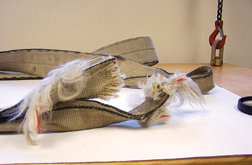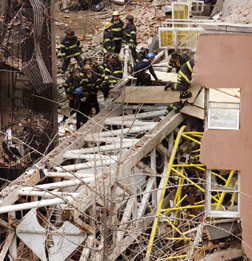 Industrial Training International INC Parnell investigated a West Coast sling failure caused by a worn-out lifting hook.
|
Master rigger Mike Parnell walks up to a rack and picks up what looks like a giant rubber band. In reality, it is a 10-ft-long, 2-in.-wide lifting sling made of thin, yellow nylon webbing. Parnell runs his fingers over the pilled, faded, oil-stained surface. “Your hands will tell you more than your eyes,” he says, as he flips the material over for further inspection. Under the roof of a Chicago-area manufacturing plant, Parnell puts down the strap, wipes his hands on his jeans and concludes that the sling needs to be replaced.
“It’s given its life,” says Parnell, president of Industrial Training International Inc., a Woodland-Wash.-based lift-and- rigging consulting company. He later inspects several other slings inside the factory and fails them, too. Workers might continue to put the slings into service, so Parnell advises someone on the factory floor to get replacements. As Parnell talks, the worker nods his head and then goes back to assembling.
Companies hire experts like Parnell to evaluate risks, but he also gets involved as a forensic expert when things go wrong. As an inspector, “My job is to expose the wounds and warts,”says Parnell. “I’m not going to do them any good by being a nice guy.” The 2-in. sling may cost the owner $50 to replace, but it could end up costing much more if it broke during a lift. Nine times out of 10, slings and other rigging fail because they were not used properly, Parnell and others say.
|
Naturally, the controlled environment of a factory is not the ever-changing landscape of construction. But the principles of safe rigging—using strong hitches, minding a load’s center of gravity, selecting the right sling, calculating capacity under different load angles, and throwing out damaged hardware—are the same. In the aftermath of deadly high-rise building accidents in Manhattan and Miami that caused tower-crane pieces to rain down into the streets and apartments below, trainers, inspectors and employers are paying more attention to rigging hazards under the hook.
Some are calling for certification of riggers and crane erectors. Others are scrutinizing synthetic slings, made of nylon or polyester, which forensic experts say are often misused and improperly maintained. The slings are easier to handle than heavier ones, but are safe if used properly, they say. Rigging experts also note that more attention should be paid to training craft workers in basic lifting gear, such as shackles, chains and hooks. A quick inspection will indicate whether they are ready to go onto the hook or into the garbage.
Recipe for Disaster
 AP/Wideworld |
 AP/Wideworld Top collar slid into tie-ins below, knocking out support. Photos show minimal rigging attached to the assembly (see arrows)
|
Clues into the recent accidents (both are still under investigation) point more to failures in rigging rather than the operation of the cranes. In Miami, a tower crane’s vertical mast section, which is secured with rigging before it is bolted into place, fell during a tower-climbing maneuver. In New York, a crane toppled when its lateral supports—also secured with temporary rigging—slipped and fell just before a climb.
Making sure crews are on the same page before a climb, and having the necessary rigging available, is the key to safety, contractors say. “It has to be planned,” says John Langford, corporate safety director for Chicago-based James McHugh Construction Co.
Before climbing a tower crane, riggers or ironworkers first install a square beam assembly called a “collar” that wraps around the crane’s vertical mast. They then bolt it to “struts,” beams that act like a “leash” tying the crane to the building. Manufactuers require collars installed at varying floors as the project progresses in order to ensure stability.
Workers climb the crane using an intricate set of hydraulic jacks and modular tower sections. It is a delicate procedure: When the top of the crane is jacking up, its turntable, horizontal jib and counterweight are all bolstered by temporary supports and hardware. “You got a lot riding on that rigging,”says Mike Drew, a veteran crane operator and training instructor for operating engineers’ union Local 150 in Chicago.
A source close to the New York accident, which killed seven people, says a mix of improper rigging and sling selection likely led to the failure. “It’s not a crane problem, it’s a problem with the rigging procedure,” says the source, who asked not to be named. Photography and other materials that ENR obtained confirm that something went terribly wrong with the rigging. Crews were preparing to jump the jib superstructure by attaching a new collar, which comes from the factory in two C-shapes that bolt together. Two come-alongs (hand-operated blocks with chains) were shackled to lifting lugs welded on top of the collar. The come-alongs were supported by two nylon web slings hung from the tower’s mast members above.
Pictures after the accident show the come-alongs still dangling from the collar, which had lost support and slid to the ground, knocking out lower collar supports. Cut and tensile-torn nylon slings appear to be hanging from the chain-block hooks. Wires twisted around the collar also appear to have supported part of the assembly while it was still in the air.
While tower-crane makers typically specify one or more slings on each leg of the collar, the New York collar appears to have been minmally supported. Rigging experts also note that cuts from hard edges (and tower crane chords would apply) are a common cause of sling failure. “Too often, we’re pairing the wrong rigging...
 Related Link:
Related Link: 
Post a comment to this article
Report Abusive Comment